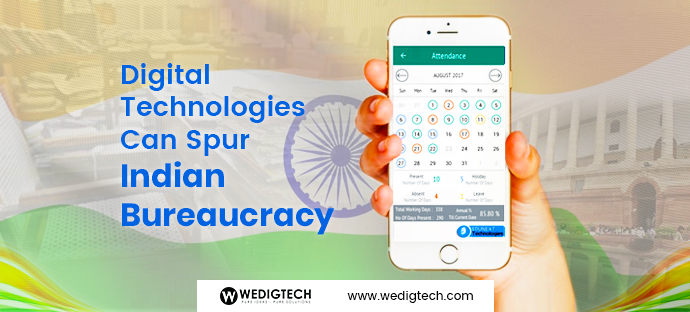A heap of digital initiatives like e-payments, e-health, and digital literacy is expected to improve governance in India.
India is a country that has navigated its way through some very tough times and hurdles. The navigation was sometimes slow, often fast, but the country always moved in the forward direction.
Since 2014, many different policies like Digital India, Skill India, Make in India, Startup India and ‘Smart Cities’ have been introduced to remove the bureaucratic red-tapism in the country.
Most of these efforts are focusing on transforming the governance by accelerating socio-economic development with the optimum use of reliable networks, widespread connectivity, and intelligent technologies.
Many companies like WeDigTech. are contributing in this digital facelift and the slow and steady steps in this transformation will soon make India the leader in the world economy.
With a GDP growth rate of 7.2%, India is the fastest growing economy in the world. The present digital revolution has ignited the introduction of transformative changes in the fields like payments, health, literacy, farming, finance, geographic mapping, rural development, social benefits programs, and many more.
The Challenges to Digital Revolution
India has vast and diverse geographical premises, so challenges while bringing the change are bound to happen.
However, what makes India strong is the flexibility in the economy, the way we convert challenges into opportunities, and the collective efforts of the citizens to get rid of the barriers.
The median age of an Indian citizen is the lowest as compared to other major economies, which makes the country equipped with a larger workforce. With the growth in working age, grows the opportunities and option to save and invest that strengthen economic competitiveness.
A younger and diverse workforce means more innovative minds. Companies like WeDigTech are majorly comprised of the young team members who collectively work on different innovative ideas to bring the change and uplift the society as a whole, not just in terms of technology. Although, India must take advantage of the technology to effectively train people and increase their efficiency, keeping the entrepreneurial spirit burning.
There is also a great opportunity for women and young students as the country continue to invest in science and technology to bring excellence in education.
The mass migration of people from rural areas to urban areas has surged the demand for infrastructure, transportation, and buildings. The interconnectivity between the cities’ economy is a major drive force for growth.
The nationwide programs like Make in India and Digital India have already adopted the advanced technologies like cloud platforms and applications to help build a modern and technology-driven nation.
Many IT companies including WeDigTech are largely supporting such national initiatives to develop an work on the technologies in India only, rather than being dependent on other technologically advanced countries like China and Japan.
The cloud technology is best suitable for rapidly developing economies like India as it reduces the cost of technological expenditure, creates opportunities for new services and products, encourages SME, start-ups, and NPOs, and facilitate collaboration and knowledge sharing between various sectors and sections of the economy especially farmers, rural entrepreneurs, and artisans.
The Union Budget 2018 is proof that government too, is focusing on emerging technologies such as Artificial Intelligence (AI), machine learning, robotics, and blockchain to infuse into nation-building.
The Solutions to Indian Bureaucracy
Digital technologies have the transformative and disruptive powers to drastically improve governance and make bureaucrats more accountable.
Here are 3 ways, in which digital technologies can significantly improve public sector capacity and accountability relatively quickly.
- Digital Monitoring
Particularly in rural areas, absenteeism among teachers, doctors, and nurses from schools and clinics is quite prominent because it is difficult to monitor their attendance.
Even the supervisors who are supposed to monitor such people sometimes become absent from their jobs.
Mobile phones can lessen the absenteeism in these areas as it provides a tamper-proof record of attendance and the information can be quickly aggregated and visualized even from the remote corners.
Countries like India, Pakistan, and Uganda are already performing mobile phone based monitoring and the impact evaluations display 25% fewer absenteeism rates of government service providers.
WeDigTech is providing such solutions PAN India which you can use to lessen absenteeism in your organization.
- e-Government
Automation of tasks and reduction in the discretion of public officials, increase state fiscal capacity, reduce exposure in expenditure, and improve transparency.
The National Rural Employment Guarantee Scheme (NREGA) in India witnessed a 35% decline in the diversion of funds with the introduction of biometric registration, verification and payments system.
Procurement competitiveness has been increased with electronic tendering of contracts, which led to better roads in India and Indonesia.
Around 16% tax compliance costs (time to prepare return file and pay taxes) has been reduced with electronic filing and payment of taxes.
- Digital Feedback
Introducing digital feedback mechanisms to the citizens works well with the e-governance.
This includes setting up of one-stop computerized services centers for a variety of administrative services like licensing and registration.
Such centers will heavily rely on information technology: for processing applications, for tracking status and progress of the applications and to receive feedback from the customers to rate the service providers.
WeDigTech has become a known name in India for developing such kind of Tech solutions which rely heavily on the advanced technologies and bring the desired output.
Conclusion
Digital technologies cannot act completely alone as they always require some amount of human involvement like committed managers and political leaders to leave a larger impact.
Digital monitoring of absenteeism will work great if there will be some rewards and penalties tied to attendance and non-attendance, respectively.
e-Governance might fail without strong political ownership as bureaucrats and other interested parties tend to resist such reforms.
Digital feedback will only work if citizens get any incentive to use the channel, like fast and necessary actions on the feedback.
However, these things show that digital technologies can remove the bureaucracy that is commonly found in the governance by providing a platform to experiment with resolutions of insurmountable problems.
e-Bureaucracy is, therefore, the entry point to transform bureaucracy.
Reach out to WeDigTech for more information on how technology can bring change to the typical bureaucratic system and receive an absolutely free consultation on the technologies that can help India become the next tech giant of the World.












